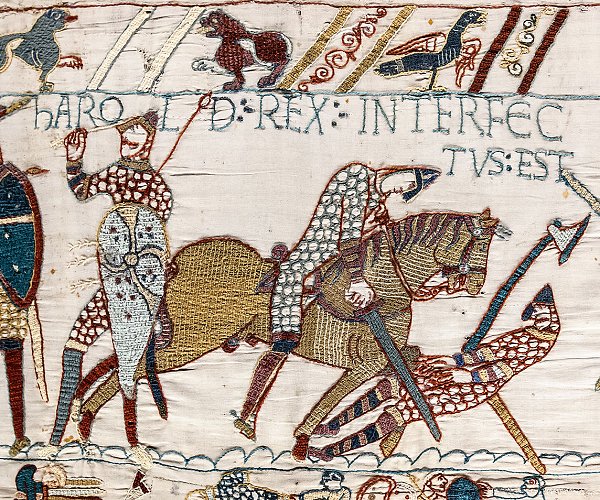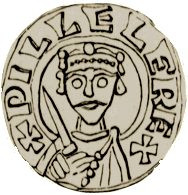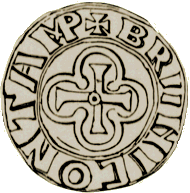|
Beginnings
Prehistoric inhabitants
Sandwell Priory ruins in Sandwell
Valley Country Park were excavated by Dr Mike Hodder
between 1982 and 1987. His finds include prehistoric
artefacts that were made by prehistoric residents. The
finds include more than 800 worked flints, that were
made from local pebbles found in clay deposits and
shaped and sharpened for use as arrowheads, scrapers and
piercers, long before metal was used. Post holes were
discovered which suggested that temporary or permanent
dwellings were there. Burnt mounds were also discovered
that were carbon dated to 2,970BC, plus or minus 160
years. They were situated close to streams and could
have been used to heat water for cooking or for
primitive saunas and suggest that the settlement was a
permanent feature.
Roman Britain
Little is known about the Roman occupation of West
Bromwich. The excavations at Sandwell Priory revealed
some small pieces of Roman pottery, two Roman coins and
part of a Roman brooch that dates from 50 to 70AD.
There has been much speculation
about Roman Roads, which must have been in the area,
including the possibility that part of the main Holyhead
Road was originally Roman.
Traces of a
Roman road have been found at Bilston and Roman coins
from the first century were found at Wednesbury in 1817,
including examples from the reign of Nero, Vespasian,
and Trajan. Another Roman coin was found at Wood Green
during the excavation of the railway cutting, and a piece of
Roman glass came to light in Monway Field, Wednesbury. A Roman brooch was recently found at Aldridge
and other
Roman coins have been found in Bilston, Perry Barr,
Great Barr, Barr Beacon, and at Stonnall, near Walsall
Wood.
Anglo Saxons
Most of South Staffordshire and the
West Midlands was originally covered by forest, scrub
and marsh. Early colonisation started in the 6th century
when Anglo-Saxons came from France, The Netherlands,
Germany and Denmark.
Angles and Saxons first reached our
shores during the Roman occupation and were mentioned by
the Roman historian Ammianus Marcellinus who considered
them as barbarians, along with the Picts and Scots. He
mentions raids in 365, and the mid-fifth century, the Gallic
Chronicle records a large raid in 410 after the Roman
army had departed.
At this time there were frequent
raids by continental pirates and many towns employed
mercenary soldiers for protection. These soldiers were
Angles and Saxons from northern Germany who brought
their families with them and were given farmland as
payment for their services. Soon the mercenaries
realised that they were stronger than their employers
and so began to take over the running of many areas. The
Anglo-Saxons slowly colonised England, moving northwards
and westwards, pushing the native Celts into Cornwall,
Wales and Scotland. By 850AD there were three competing
kingdoms; Mercia, Northumbria and Wessex.
South Staffordshire was a part of
Mercia, which was derived from the old English word “Mierce”,
meaning people of the boundaries. The kingdom developed
from settlements in the upper Trent valley and was
colonised by a band of Angles called the Iclingas.
Slowly the area was populated and the kingdoms of the
Saxon and Angles in the midlands amalgamated to form the
kingdom of Mercia. In 913 Stafford became the capital of
Mercia after it had been fortified by Queen Aethelfaed.
In about the 8th century, a tribe
called the Anglian Mercens came from the north.
Initially they followed the Trent Valley, and began
spreading along the valleys of the Tame and its
tributaries. They were known as the Tomsaetan (dwellers
by the Tame), and would have settled here. There were
several natural advantages for them in this area, the
ready-made clearings, a good water supply from the local
brooks, and a slightly elevated position making the site
easily defendable.

Cannock Forest and the River Tame.
Settlers moving into the area would
have found or made clearings in the woodland to build
their houses, keep their cattle and grow their crops.
Evidence for such clearings and settlements can be found
in many of the names of local towns. The old English
word “leah” means a woodland clearing and can be found
in some local place names:
Bentley, Brierley Hill, Coseley,
Cradley Heath, Dudley, Sedgley and of course the area in
Darlaston known as The Leys.
The old English word “halh” meaning
a pocket of land appears in Willenhall and the word
“tun” meaning a settlement is found in Bilston,
Wolverhampton and Darlaston.
There would have been a tiny
settlement in the West Bromwich area by the 8th century.
The area was known as ‘Bromwic’ meaning a settlement in
the broom. The open heathland in the area must have been
covered in broom. It was surrounded by part of Cannock
Forest, where the Mercian Kings hunted wild boar,
wolves, and possibly deer. Another surviving place name
from that time is Lyndon, which means a settlement in a
flax field.
|
|
| Read
about Anglo-Saxon England |
 |
| |
|
| The
Norman Invasion The Normans were
descended from Vikings, who had settled in
Normandy, married into the local population
and adopted the French culture. It is
believed that in 1051 King Edward of England
named his distant relative, William Duke of
Normandy as his successor. So William had
claim to the English throne.
Edward died on the 5th January, 1066 and
on the following day, Harold was crowned as
the new king in Westminster Abbey. His
rivals to the throne had been William Duke
of Normandy and Harald Hardrada of Norway.
The Norman invasion had been expected and
so Harold made plans to defend the country.
The
Anglo-Saxon Chronicle claimed that by June
1066 Harold had gathered such a great naval
force, and a land force also, as no other
king in the land had gathered before. His
plans however, were thrown into
disarray when his estranged brother Tostig,
Earl of Northumbria and Harald Hardrada of
Norway led an invading army from the
northeast. |
|

A Harald Hardrada
coin. |
At the beginning of September, 1066,
Harald Hardrada's army raided Scarborough
and slaughtered most of its inhabitants. On
the 20th September, Hardrada and Tostig won
a battle at Fulford Gate and on the 24th
September they captured York.
Harold and his English
army travelled the 200 miles from London to
York and fought the invading army at
Stamford Bridge, on the 25th September. Both
Hardrada and Tostig were killed during the
battle and large numbers of their troops
were drowned in the River Derwent.
Harold heard that William of Normandy had
landed at Pevensey Bay on 28th September
with an invading army, possibly whilst
celebrating his victory in York. |
|
Harold and his troops quickly returned to
London, waiting there for about a week
before travelling south again. He had hoped
that some of the northern English troops
would join him there, but they didn't
materialise. Harold and his army marched
south and camped at Caldbec Hill,
just over 8 miles to the north west of
Hastings, on the night of the 13th October.
Harold and his 7,000 strong army were at a
great disadvantage because they were
suffering from the exertions of their
previous battle and the 240 mile long march
from the north.
Harold had taken a
defensive position at the top of Senlac
Hill, now called Battle. On the 14th
October, Harold and his army were defeated.
During the battle, Harold and many of his
troops were killed. The traditional account
of Harold dying from an arrow to the eye and
brain dates to the 1080s, but of course is
unproven. William was crowned in London on
Christmas day 1066. |
|

The image of the
wounded King Harold on the Bayeux Tapestry. |
After the invasion, the Normans
quickly gained control of the southern
part of the county, but were met with
hostility in the north and east. King
William initially had control of the old
kingdoms of Essex, Kent, Wessex, Sussex
and part of Mercia. Edwin Earl of Mercia
and his brother Morcar, Earl of
Northumbria, were delighted that William
had overthrown the Godwin family in
Wessex. They believed that he would be
satisfied with the territory he had
already gained and so would leave them
in control of their kingdoms. If they
had understood their true situation and
attacked William before he became
established, they may have been able to
overthrow him.
Three months after his coronation, King
William returned to France and took with
him the people who were most likely
cause trouble while he was away,
including Edwin and Morcar. During his
absence, unrest began to grow and there
was an attempted invasion by Eustace,
Count of Boulogne, who was Edward the
Confessor’s brother-in-law.William
hastily returned in December 1067 and
set about consolidating his hold on the
country. He took Exeter after an 18 day
siege and began to build castles at
important sites. His wife Matilda
arrived here in 1068 and was crowned
Queen. When he returned to Normandy in
1069, one of his most formidable
lieutenants, Robert de Commines, and 500
of his followers were slaughtered after
a drunken debauch in Durham. The Norman
castle at York was besieged and on the
king’s return he put down the rebellion
and sacked York. William was hated by
many of the English and more resistance
to his rule was to follow.
William and his army swept through
the northern counties from Shropshire to
Durham and the Scottish borders on a
mass killing spree. Villages were
burned, animals slaughtered, crops
destroyed and any survivors were left to
starve. This led to the deaths of over
100,000 people and effectively ended any
further resistance in this part of the
country.
A Danish fleet arrived off the
Northumbrian coast to lend support to
the general uprising. This was led by
King Swein who had as much claim to the
English throne as William, if not more.
He was the nephew of King Canute and was
joined by Edgar the Atheling who was the
main English claimant to the throne.
William managed to buy-off the Danes and
Edgar fled to Scotland. |

An engraving of a
silver penny from King William's reign. |
The final English revolt took place
in the fenlands of East Anglia in 1071.
Hereward the Wake led a number of raids
on the Normans from the safety of the
marshes around Ely. He was joined by
Earl Morcar, whose brother Edwin had
been murdered by his own men. William
sent troops into the marshes and
defeated the Saxons. Hereward escaped
but Morcar was captured and imprisoned.
William felt that he could not trust the
Saxons at all and the remaining Saxon
landowners had their lands confiscated
and given to trusted Normans. After 1066
most of Mercia still belonged to Earl
Edwin of Mercia, but after his death the
estates were divided amongst William’s
followers. Much of local Mercia
including Dudley was given to Ansculf of
Picuigny who built a motte and bailey
castle at Dudley. |
Under William the medieval feudal system
continued to be used. William owned all of
the land and divided it up into areas, which
were each ruled by a tenant in chief who was
one of his trusted barons. They each
controlled their area in return for payment
from taxes and supplied soldiers for the
king’s army. Each area was divided into
smaller areas (manors) that were controlled
by the baron’s knights, who were called
lesser or mesne tenants. They had to take an
oath of loyalty, carry out any required
duties and pay taxes for their land. Each
manor would include several villages whose
inhabitants were called peasants. There were
several classes of peasant. The highest was
a freeman who was free to pursue a trade.
The other classes were owned as part of the
land and were not free to move around.
They were villiens, bordars, cottars and
serfs. A villien offered agricultural
services to his lord, a bordar was a
smallholder who farmed on the edge of a
settlement, a cottar was a cottager and a
serf was an agricultural labourer. In return
the lord of the manor was supposed to
protect and help them. The other major
landowner was the church and bishops and
abbots could be tenants in chief or lesser
tenants.The original
Dudley Castle, a simple wooden motte and
bailey, was constructed in 1070 by Ansculf
de Picquigny, father of William Fitz-Ansculf,
who succeeded him. At this time the town
served as the seat of the extensive Barony
of Dudley, which possessed estates in eleven
different counties across England: Stafford,
Warwick, Worcester, Surrey, Berkshire,
Northampton, Buckinghamshire, Rutland,
Oxford, Middlesex and Huntingdon.
William Fitz-Ansculf was
in control of more than 80 manors, scattered
across several counties and like his father
was based at Dudley Castle. His holdings
included Amblecote, Aston, Birmingham,
Bushbury, Chasepool, Edgbaston, Enville,
Erdington, Essington, Great Barr, Handsworth,
Himley, Moseley, Newport Pagnell, Orton,
Oxley, Pendeford, Perry Barr, Sedgley,
Seisdon, Trysull, Upper Penn and Lower Penn,
West Bromwich, Witton and Wombourne.
As the country settled down under Norman
rule, William wanted to ensure that he
received all of the taxes that were owed to
him. This was very complex because the
country had been divided into a large number
of tax paying manors. The solution was the
Domesday Book and work on it began in 1085
when teams of investigators toured the
country. The information gathered from all
over the country was collated into the book
at Winchester and from this precise taxes
could be calculated. |
| When a team of investigators arrived in
an area they would meet with the landowner,
the local priest and a group of older
villagers. The information gathered was as
follows: The name of each tenant-in-chief,
tenant and under-tenant, the total amount of
land, the amount of land under cultivation,
the amount of woodland, the number of
people, animals and ploughs and any
fishponds or mills.
The Domesday Book was not completed until
after King William’s death on 9th September
1087. Today it is the most important source
of information about village life in the
Middle Ages. |

An engraving of the
reverse side of a silver penny from
William's reign. |
|